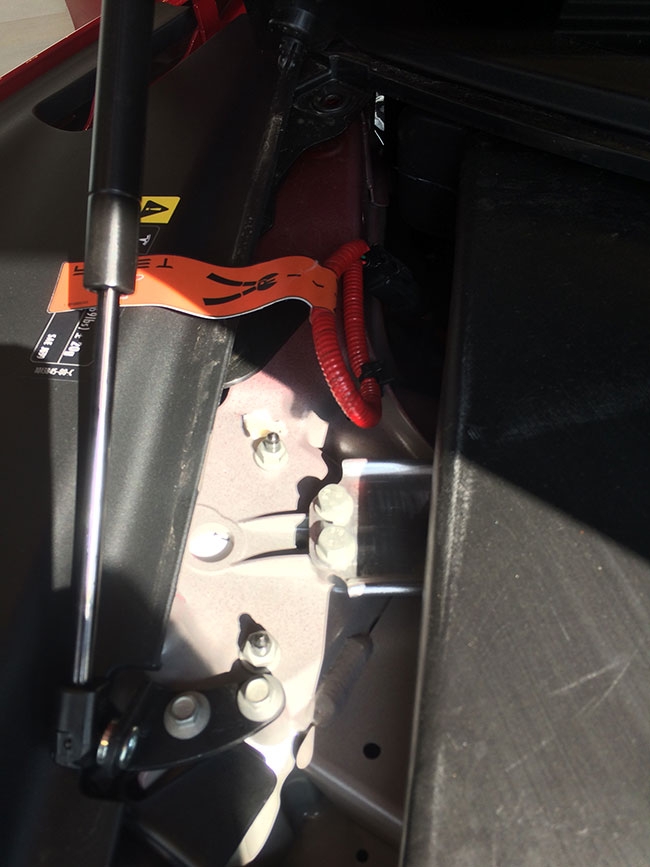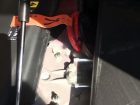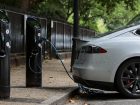
Extrication tips: April 2018
By Chad Roberts
Features Extrication Training Chad RobertsIn looking back at Extrication Tips columns from the last year, we’ve managed to touch on a back-to-basics approach for auto extrication, a system for controlling extrication (SHADE), and a two-part patient care series.
 The orange cable is the high voltage disconnect on a Tesla Model S. High voltage disconnects can look different depending on the manufacturer In looking back at Extrication Tips columns from the last year
The orange cable is the high voltage disconnect on a Tesla Model S. High voltage disconnects can look different depending on the manufacturer In looking back at Extrication Tips columns from the last yearThis issue, I thought it would be fitting to tackle something that is becoming more prevalent on our roads today: electric and hybrid vehicles. Although this is a very broad topic to cover in one article, I’m going to try and sum up the basics, including vehicle hazards and shut down procedures, while dismissing some commonly-held electric vehicle misconceptions.
Electric car sales are on the rise so we must start to accept these vehicles as an everyday hazard. However, with technology changing faster than this article can be written, our first concern is identifying these alternative vehicles and addressing what type of electric vehicle they really are.
The first type is the hybrid electric vehicle (HEV) such as the Toyota Prius. This electric vehicle derives its power from two sources. The first being the internal combustion engine and the second being the electric motor powered by a battery source that is charged solely by the combustion engine and regenerative braking (power that is transferred using the vehicles braking system to recharge the high voltage battery). The next type is the plug-in hybrid electric vehicle (PHEV), such as the Ford C-Max. These vehicles are very similar to HEVs, however they have the capability to be plugged in to an external power source to help recharge the high-voltage battery. Then there is the electric vehicle (EV) – a true electric vehicle, with no other means for power other than the on-board high-voltage battery packs that are charged by an external power source plug-in. These are very quickly becoming the most popular options as newer technology is improving battery life and therefore overall range or distance for cars such as a a Chevrolet Bolt or Tesla. Lastly, there is the extended range EV, which has the addition of an on-board gasoline generator that recharges the high-voltage batteries while the vehicle is in motion when more range is required, like the Chevrolet Volt.
Now that we’ve identified the different types of high-voltage electric vehicles, let’s look at how the high-voltage system works so we can understand the best ways to mitigate any issue we find. Overall power for electric high voltage cars can be broken down into direct current (DC) and alternating current (AC). DC moves in one direction and is mainly power driven by batteries, while AC can switch directions and go back and forth many times per second. AC is commonly found in residential and commercial settings. While different in many ways, they both have one main thing in common; each require a complete path or circuit for the current to flow. From this basic principle we can start looking at how the circuit applies to electric vehicles and guides our shut down procedures. To make this as simple as possible, we are going to consider five different high-voltage components. In this scenario, the team would use a 12V battery, DC-to-AC inverter, DC-to-DC converter, relay switch and high-voltage cables (universally identified by their orange colour). To get the high-voltage system running, electric cars use a 12V battery to start up much like conventional vehicles. Once the vehicle is powered up, the DC-to-DC converter will start to receive power, which charges the 12V battery and powers low-voltage systems like SRS air bags. But more importantly, the DC-to-DC converter closes the “relay switch” and ensures it remains closed. This completes the closed circuit the high-voltage system needs to convert DC power from the battery packs to AC power to run the electric motor. The DC-to-AC inverter can also transfer current back to the high-voltage battery by using regenerative braking.
I know electric vehicle operations may seem tough to follow, but don’t get discouraged. When looking at shut down procedures it’s really quite simple. The first option is to disable the vehicle in two phases. First, locate and shut down the vehicle ignition – this will open the relay switch and kill the high-voltage system. Next locate and disable the 12V battery to kill power to the DC-to-DC converter and isolate any power to the low-voltage and air bag systems.
Our next option for vehicle shut down is useful in a situation where crews cannot turn off the vehicle ignition cannot due to damage or inaccessibility. The first step is to disconnect the 12V battery. Then locate and pull the high-voltage control fuse, which will disconnect any 12V power to the DC-to-DC converter, opening the relay switch to kill the high-voltage system. The only issue with this option is that these control fuses can be located in different locations depending on the manufacturer. Some are easily identifiable, like the most recent Tesla models shown in Photo 1, whereas you may need to refer to the owner’s manuals or the NFPA Emergency Field Guide for some models.
Now that shut down procedures have been addressed, let’s look at some of the most common incidents and safety concerns that make crews think twice when they encounter an EV on the scenes.
First, let’s address the car fire. When faced with an EV that is on fire, one clear thing must be assessed: has the fire involved the high-voltage battery packs? If so, no need to worry, as the chance for electrocution with water application is non-existent. The main issue that crews need to be concerned with is establishing a good water supply, as battery packs may require more water to extinguish. Full PPE and SCBA are also required as burning battery packs can create caustic and toxic fumes. The only remaining issue with battery pack fires is re-kindling. High-voltage battery packs can hold heat for a long period of time, so firefighters need to ne aware of this.
Next is the submerged EV. Is there a potential for electrocution? And the answer is simply, no. With the entire high-voltage system isolated from the vehicle chassis, there is no potential for electrocution when touching the submerged vehicle. Some things to keep in mind are to avoid all high voltage systems and cables, and never attempt to remove a wet or submerged high-voltage control fuse.
What about extrication? When doing cutting, prying or pushing, avoid high-voltage system components and orange high-voltage cables. Most of these systems and cables are located on the underside of the vehicle or outside of areas that are generally used to access patients.
Damaged batteries can potentially generate heat, so ventilation may be required. However, any leaks from high-voltage batteries should be minimal as they are dry-cell batteries. Simply follow the same vehicle shutdown procedures as mentioned above before beginning the extrication process.
And lastly, we will address when an EV and its charging station is on fire, or a situation where the charging station is damaged. When presented with this situation, don’t over think it. The EV and charging station fire should simply be treated as a typical Class C fire until the power can be isolated. Once isolated, accomplished, extinguish the fire and follow the same vehicle shutdown procedures as mentioned earlier.
Although this is not the ultimate guide to hybrid and electric vehicle emergency operations, this article provides a broad overview and safe approaches to an emerging issue facing the fire service. When dealing with an incident involving an EV: just remember the five high-voltage system components, disable the vehicle using the two-stage process and don’t fall prey to tunnel vision. If we apply the proper shutdown procedures, assuming that all high-voltage systems are always live, we will begin to understand these vehicles are not all that different.
So until next time, be smart and never stop watching, reading and listening.
Chad Roberts is a firefighter in Oakville, Ont., and works on a heavy rescue. He is a member of the Oakville extrication team and competes and trains across North America. chadroberts12@gmail.com
Print this page


